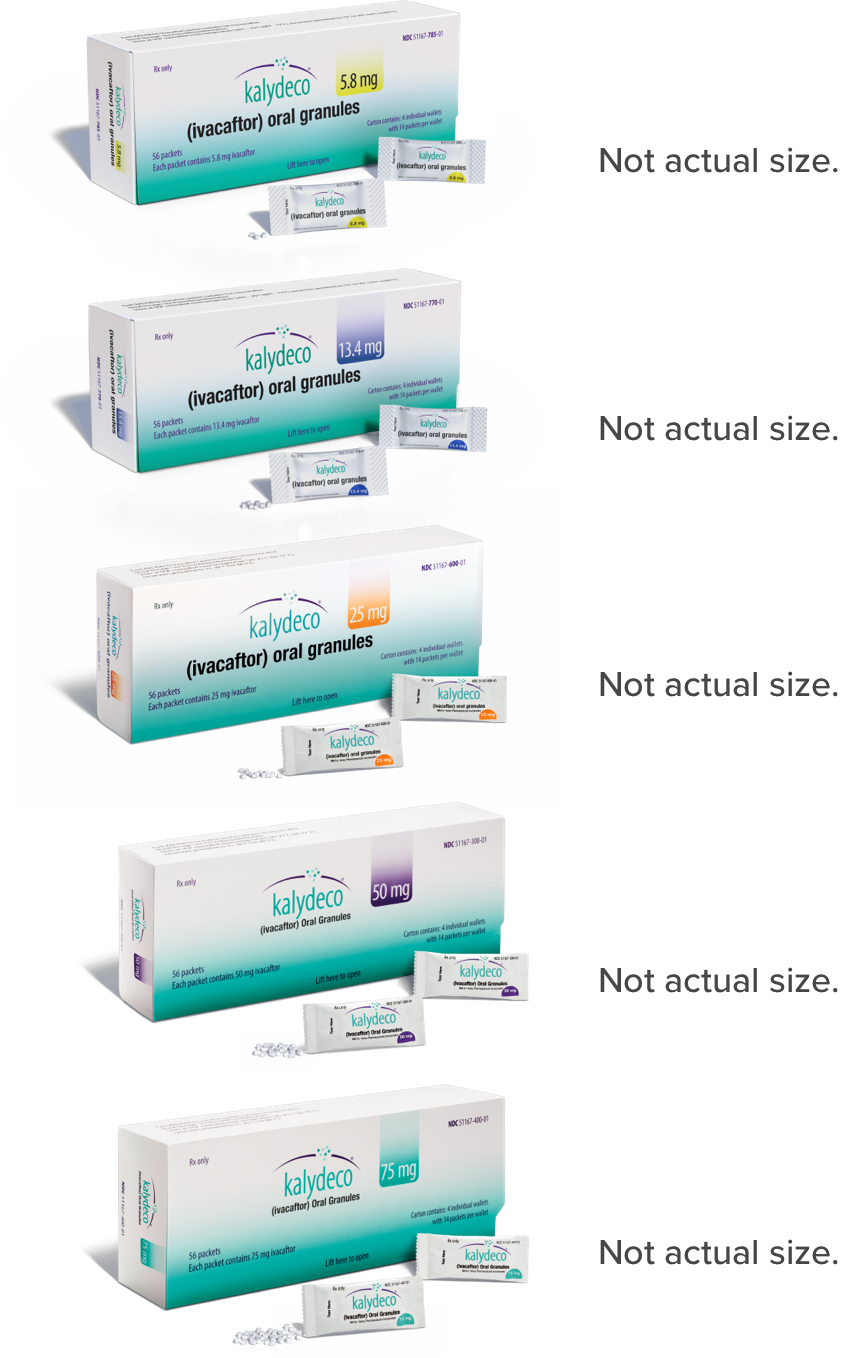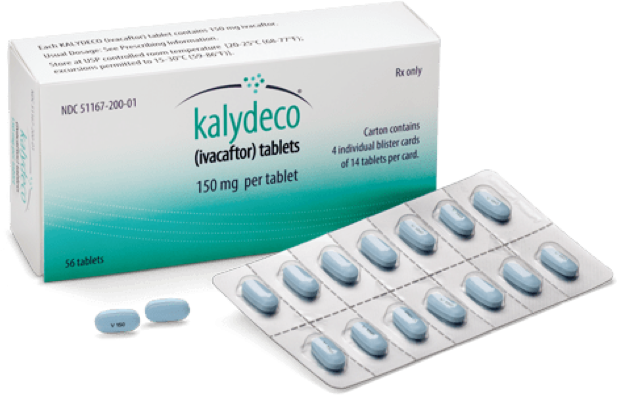Take KALYDECO every 12 hours or as directed by your healthcare provider
- Taking KALYDECO every 12 hours helps keep enough medicine in the body
- Remember, taking KALYDECO every 12 hours is not the same as taking it twice a day
- Your healthcare provider may prescribe a different dose or frequency for KALYDECO
Always take KALYDECO with fat-containing food
- Fat-containing food helps the body absorb KALYDECO better
See examples of fat-containing foods.
- Avoid foods and drinks that contain grapefruit, as these may affect the amount of KALYDECO in the body
Take KALYDECO, plus all your other cystic fibrosis (CF) therapies, exactly as your healthcare provider tells you to take them
- Be sure to talk to your healthcare provider before starting, changing, or stopping any CF therapies or other medications, including prescription and non-prescription medicines, vitamins, and herbal supplements
Before you start taking KALYDECO, be sure KALYDECO is right for you.
To learn how to take KALYDECO oral granules or tablets, from how they're supplied to step-by-step instructions, choose one below.
KALYDECO is supplied as oral granules for children with CF age 1 month to less than 6 years old
Meet Grant and learn how to take KALYDECO oral granules
View Important Safety Information and full Prescribing Information, including Patient Information, for KALYDECO.
How KALYDECO oral granules are packaged

Each box of KALYDECO oral granules contains 4 wallet cards for a total of 56 unit dose packets—or a 28-day supply of granules.
Each wallet card contains 14 doses. This is enough for a week based on dosing twice a day every 12 hours.
KALYDECO granules are available in 5 different strengths (5.8-mg, 13.4-mg, 25-mg, 50-mg, and 75-mg packets). Your loved one's doctor will prescribe the appropriate dose based on your loved one's weight.
KALYDECO oral granules recommended doses
| If your child is: | And weighs: | The recommended dose is: |
|---|---|---|
| 1 month to less than 2 months old |
3 kg or more (~7 lb or more) |
One 5.8-mg packet every 12 hours Total daily dose: 11.6 mg |
| 2 months to less than 4 months old |
3 kg or more (~7 lb or more) |
One 13.4-mg packet for every 12 hours Total daily dose: 26.8 mg |
| 4 months to less than 6 months old |
5 kg or more (~11 lb or more) |
One 25-mg packet for every 12 hours Total daily dose: 50 mg |
| 6 months to less than 6 years old |
5 kg to less than 7 kg (~11 lb to less than ~15 lb) |
One 25-mg packet for every 12 hours Total daily dose: 50 mg |
| 7 kg to less than 14 kg (~15 lb to less than ~31 lb) |
One 50-mg packet for every 12 hours Total daily dose: 100 mg |
|
| 14 kg or more (~31 lb or more) |
One 75-mg packet for every 12 hours Total daily dose: 150 mg |
| If your child is: |
| 1 month to less than 2 months old |
| And weighs: |
| 3 kg or more (~7 lb or more) |
| The recommended dose is: |
| One 5.8-mg packet every 12 hours Total daily dose: 11.6 mg |
| If your child is: |
| 2 months to less than 4 months old |
| And weighs: |
| 3 kg or more (~7 lb or more) |
| The recommended dose is: |
| One 13.4-mg packet for every 12 hours Total daily dose: 26.8 mg |
| If your child is: |
| 4 months to less than 6 months old |
| And weighs: |
| 5 kg or more (~7 lb or more) |
| The recommended dose is: |
| One 25-mg packet for every 12 hours Total daily dose: 50 mg |
| If your child is: |
| 6 months to less than 6 years old |
| And weighs: |
| 3 kg to less than 7 kg (~11 lb to less than ~15 lb) |
| The recommended dose is: |
| One 25-mg packet for every 12 hours Total daily dose: 50 mg |
| If your child is: |
| 6 months to less than 6 years old |
| And weighs: |
| 7 kg to less than 14 kg (~15 lb to less than ~31 lb) |
| The recommended dose is: |
| One 50-mg packet for every 12 hours Total daily dose: 100 mg |
| If your child is: |
| 6 months to less than 6 years old |
| And weighs: |
| 14 kg or more (~31 lb or more) |
| The recommended dose is: |
| One 75-mg packet for every 12 hours Total daily dose: 150 mg |
How often should my loved one take KALYDECO?
- Give your loved one KALYDECO every 12 hours with fat-containing food unless otherwise directed by your healthcare provider
- Your healthcare provider may give you different instructions on how much KALYDECO to give your loved one and when you should give it
How to give your loved one KALYDECO oral granules
Step 1: Preparation
- Hold 1 packet of KALYDECO oral granules with the cut line on top
- Shake the packet gently to settle the KALYDECO granules
- Tear or cut the packet open along the cut line
- Carefully pour all of the KALYDECO granules into 1 teaspoon (5 mL) of age-appropriate soft food or liquid and mix. Food or liquid should be at or below room temperature
- Here are examples of soft foods and liquids you can mix KALYDECO granules into. Remember, every child is different, so be sure to talk to your healthcare provider about what the best options are for your loved one
- Breast milk
- Applesauce
- Infant formula
- Water
- Puréed vegetables and fruits
- Milk
- Yogurt
- Juice
- Then, mix the granules with the 1 teaspoon of food or liquid
Step 2: Administration
- Give KALYDECO to your loved one within one hour of mixing
- Make sure the entire medicine mixture is taken
Step 3: Fat-containing food before or after the dose
Always give KALYDECO to your loved one with a fat-containing food
- Make sure to give your loved one age-appropriate fat-containing food just before or after the dose of KALYDECO granules. This helps the body absorb KALYDECO better
- Here are suggestions for fat-containing foods to give your loved one:
- Breast milk
- Infant formula
- Eggs
- Butter
- Peanut butter
- Cheese pizza
- Whole milk
- Whole-milk cheese
- Whole-milk yogurt
- Talk to your healthcare provider about fat-containing foods appropriate for your loved one when taking KALYDECO oral granules.
What if your loved one misses a dose of KALYDECO?
If a dose of KALYDECO is missed and it is within 6 hours of when it is usually given, give that dose of KALYDECO as prescribed with fat-containing food as soon as possible.
If a dose of KALYDECO is missed and it is more than 6 hours after the time the dose is usually given, skip that dose only and give the next dose with fat-containing food when it is usually given. Do not give 2 doses at the same time to make up for a missed dose.
KALYDECO is supplied as tablets (150 mg) for people 6 years and older.
- Each KALYDECO box contains 4 individual blister cards. Each blister card contains 14 pills—7 morning doses and 7 evening doses



Not actual size.
How often should you take KALYDECO tablets?
- Take KALYDECO every 12 hours with fat-containing food unless otherwise directed by your healthcare provider
- Your healthcare provider may recommend a different dose or frequency for KALYDECO. Take KALYDECO exactly as your doctor tells you to take it
What if you miss a dose of KALYDECO?
If you miss a dose of KALYDECO and it is within 6 hours of when you usually take it, take the dose of KALYDECO as prescribed with fat-containing food as soon as possible.
If you miss a dose and it is more than 6 hours after the time you usually take it, skip that dose only and take the next dose with fat-containing food when you usually take it. Do not take 2 doses at the same time to make up for a missed dose.
IMPORTANT SAFETY INFORMATION
Before taking KALYDECO, tell your doctor about all of your medical conditions, including if you:
- have liver or kidney problems
- are allergic to KALYDECO or any ingredients in KALYDECO. See the Patient Information for a list of ingredients
- are pregnant or plan to become pregnant. It is not known if KALYDECO will harm your unborn baby. You and your doctor should decide if you will take KALYDECO while you are pregnant
- are breastfeeding or planning to breastfeed. It is not known if KALYDECO passes into your breast milk. You and your doctor should decide if you will take KALYDECO while you are breastfeeding
What is KALYDECO® (ivacaftor)?
What is KALYDECO®
(ivacaftor)?
KALYDECO is a prescription medicine used for the treatment of cystic fibrosis (CF) in people aged 1 month and older who have at least one mutation in the cystic fibrosis transmembrane conductance regulator (CFTR) gene that is responsive to KALYDECO.
Talk to your doctor to learn if you have an indicated CF gene mutation.
It is not known if KALYDECO is safe and effective in children under 1 month of age.
Tell your doctor about all the medicines you take, including prescription and over-the-counter medicines, vitamins, and herbal supplements.
KALYDECO may affect the way other medicines work, and other medicines may affect how KALYDECO works. Ask your doctor or pharmacist for a list of these medicines if you are not sure.
Especially tell your doctor if you take:
- the antibiotics rifampin (RIFAMATE®, RIFATER®) or rifabutin (MYCOBUTIN®)
- seizure medicines such as phenobarbital, carbamazepine (TEGRETOL®, CARBATROL®, EQUETRO®), or phenytoin (DILANTIN®, PHENYTEK®)
- St. John’s wort
- antifungal medicines such as ketoconazole, itraconazole (SPORANOX®), posaconazole (NOXAFIL®), voriconazole (VFEND®), or fluconazole (DIFLUCAN®)
- antibiotics such as telithromycin, clarithromycin (BIAXIN®), or erythromycin (ERY-TAB®)
What should I avoid while taking KALYDECO?
- KALYDECO can cause dizziness in some people who take it. If you experience dizziness, do not drive or operate machines until symptoms improve
- Avoid food or drink containing grapefruit while you are taking KALYDECO
What are the possible side effects of KALYDECO?
KALYDECO can cause serious side effects, including:
- High liver enzymes in the blood, which have happened in people receiving KALYDECO. Your doctor will do blood tests to check your liver:
- before you start KALYDECO
- every 3 months during your first year of taking KALYDECO
- every year while you are taking KALYDECO
For people who have had high liver enzymes in the past, your doctor may do blood tests to check the liver more often.
Call your doctor right away if you have any of the following symptoms of liver problems:
- pain or discomfort in the upper right stomach (abdominal) area
- yellowing of your skin or the white part of your eyes
- loss of appetite
- nausea or vomiting
- dark, amber-colored urine
- Serious allergic reactions have happened to people who are treated with KALYDECO. Call your healthcare provider or go to the emergency room right away if you have symptoms of an allergic reaction. Symptoms of an allergic reaction may include:
- rash or hives
- tightness of the chest or throat or difficulty breathing
- light-headedness or dizziness
- Abnormality of the eye lens (cataract), which has happened in some children and adolescents receiving KALYDECO. Your doctor should perform eye examinations before and during treatment with KALYDECO to look for cataracts.
The most common side effects of KALYDECO include:
- headache
- upper respiratory tract infection (common cold), including:
- sore throat
- nasal or sinus congestion
- runny nose
- stomach (abdominal) pain
- diarrhea
- rash
- nausea
- dizziness
Tell your doctor if you have any side effect that bothers you or that does not go away. These are not all the possible side effects of KALYDECO. For more information, ask your doctor or pharmacist.
Use of KALYDECO in children aged 1 month to less than 6 months born from a pregnancy lasting (gestational age) less than 37 weeks has not been evaluated.
Call your doctor for medical advice about side effects. You may report side effects to FDA at 1-800-FDA-1088.
For further information, please see full Prescribing Information, including Patient Information.
People with CF pictured may or may not be taking KALYDECO.

